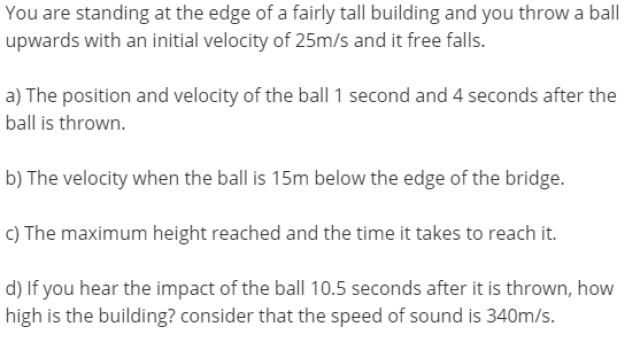Free Fall?
2021-02-22 12:33 pm
Only d)

回答 (3)
2021-02-22 5:08 pm
✔ 最佳答案
a) ...reference is done to the top of the building a1 : after 1 sec
Δh = Vo*t-g/2*t^2 = 25-4.9 = 20.1 m ; V = Vo-g*t = 25-9.8 = 15.2 m/sec
a2 : after 4 sec
Δh' = Vo*t'-g/2*t'^2 = 25*4-4.9*16 = 21.6 m ; V' = Vo-g*t' = 25-9.8*4 = -14.2 m/sec
b)...reference is done to the top of the building
t = √2*15/g = √30/9.8 = 1.75 sec
V = -Vo-g*t = -25-1.75*9.8 = -42.1 m/sec
c )
c1 : Δh = Vo^2/2g = 25^2/19.6 = 31.9 m
c2 : tup = Vo/g = 25/9.80p, = 2.55 sec
d)
h = 340*t
-h = Vo(10.5-t)-4.9(10.5-t)^2
-340*t = 25(10.5-t)-4.9(10.5-t)^2
-340t = 25(10.5-t)-4.9(110+t^2-21t)
-340t+25t-103t-263+539+4.9t^2 = 0
-418t+276+4.9t^2 = 0
t = (418-√418^2-19.6*276)/9.8 = 0.67 sec
h = 340*t = 340*0.67 = 228 m
check
t' = 10.5-t = 9.83 sec
h = -25*9.83+4.9*9.83^2 = 228 m
2021-02-22 1:11 pm
d)
Let h m be the height of the building.
Let t s be the time taken for the journey of the ball.
Then, time taken for the sound travels from the bottom to the top of building is (10.5 - t) s.
Consider the journey of the ball.
Take g = 9.8 m/s²
Take all downward quantities to be positive.
h = ut + (1/2) gt²
h = (-25)t + (1/2)(9.8)t²
h = -2.5t + 4.9t² …… [1]
Consider the sound travels from the bottom to the top of the building.
h = speed × time
h = 340 (10.5 - t) …… [2]
[1] = [2]:
-2.5t + 4.9t² = 340 (10.5 - t)
4.9t² + 337.5t - 3570 = 0
t = -337.5 ± √(337.5² + 4×4.9×3570) / (2×4.9)
t = 9.32 or t = -78.2 (rejected)
Height of the building = -2.5(9.32) + 9.8(9.32)² = 400 m
OR: Height of the building = 340 (10.5 - 9.32) = 400 m
Let h m be the height of the building.
Let t s be the time taken for the journey of the ball.
Then, time taken for the sound travels from the bottom to the top of building is (10.5 - t) s.
Consider the journey of the ball.
Take g = 9.8 m/s²
Take all downward quantities to be positive.
h = ut + (1/2) gt²
h = (-25)t + (1/2)(9.8)t²
h = -2.5t + 4.9t² …… [1]
Consider the sound travels from the bottom to the top of the building.
h = speed × time
h = 340 (10.5 - t) …… [2]
[1] = [2]:
-2.5t + 4.9t² = 340 (10.5 - t)
4.9t² + 337.5t - 3570 = 0
t = -337.5 ± √(337.5² + 4×4.9×3570) / (2×4.9)
t = 9.32 or t = -78.2 (rejected)
Height of the building = -2.5(9.32) + 9.8(9.32)² = 400 m
OR: Height of the building = 340 (10.5 - 9.32) = 400 m
2021-02-22 1:30 pm
Let t be the time for the ball to reach the ground. Then
-h = 25t - 4.9t^2 =>
0 = 49t^2 - 250t - 10h =>
t = 250/98 + (1/98)*sqrt(62500 + 1960h).
The time for the sound to come back up to the thrower is h/(340 m/s).
So you have
h/340 + 250/98 + (1/98)*sqrt(62500 + 1960h) = 10.5, or
(1/98)*sqrt(62500 + 1960h) = 10.5 - 2.5510 - h/340 =>
(1/98)^2 * (62500 + 1960h) = (1/340)^2 * (2702.66 - h)^2 =>
3.4694^2 * (62500 + 1960h) = (2702.66 - h)^2 =>
0 = h^2 - 5405.32h - 12.037(62500 + 1960h) + 7304371 =>
0 = h^2 - 28998h + 6552058.
To make this look a little easier, let h = 100u, and you have
0 = 10000u^2 - 2899800u + 6552058, or
0 = u^2 - 289.98u + 655.206 =>
u = 289.98/2 +/- (1/2)*sqrt(289.98^2 - 4*655.206)
= 144.99 +/- (1/2)*sqrt(81467.6)
= 144.99 +/- 142.71 =>
h = 14499 +/- 14271.
Not likely that the building is 28 kilometers high, so let's say
h = 228 meters.
Let's see if that works.
Time for the sound to travel upward 228 meters is 0.67 seconds.
If the sound is heard 10.5 seconds after the ball is thrown, evidently it took 9.83 seconds for the ball to fall to the ground.
-h = 25*9.83 - 4.9*9.83^2 = -227.7 m. Close enough !!
The building is 228 meters high.
-h = 25t - 4.9t^2 =>
0 = 49t^2 - 250t - 10h =>
t = 250/98 + (1/98)*sqrt(62500 + 1960h).
The time for the sound to come back up to the thrower is h/(340 m/s).
So you have
h/340 + 250/98 + (1/98)*sqrt(62500 + 1960h) = 10.5, or
(1/98)*sqrt(62500 + 1960h) = 10.5 - 2.5510 - h/340 =>
(1/98)^2 * (62500 + 1960h) = (1/340)^2 * (2702.66 - h)^2 =>
3.4694^2 * (62500 + 1960h) = (2702.66 - h)^2 =>
0 = h^2 - 5405.32h - 12.037(62500 + 1960h) + 7304371 =>
0 = h^2 - 28998h + 6552058.
To make this look a little easier, let h = 100u, and you have
0 = 10000u^2 - 2899800u + 6552058, or
0 = u^2 - 289.98u + 655.206 =>
u = 289.98/2 +/- (1/2)*sqrt(289.98^2 - 4*655.206)
= 144.99 +/- (1/2)*sqrt(81467.6)
= 144.99 +/- 142.71 =>
h = 14499 +/- 14271.
Not likely that the building is 28 kilometers high, so let's say
h = 228 meters.
Let's see if that works.
Time for the sound to travel upward 228 meters is 0.67 seconds.
If the sound is heard 10.5 seconds after the ball is thrown, evidently it took 9.83 seconds for the ball to fall to the ground.
-h = 25*9.83 - 4.9*9.83^2 = -227.7 m. Close enough !!
The building is 228 meters high.
收錄日期: 2021-05-01 22:40:48
原文連結 [永久失效]:
https://hk.answers.yahoo.com/question/index?qid=20210222043353AAkGsgM

